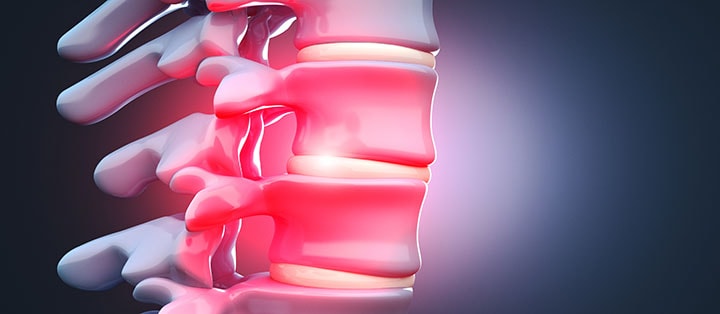Discs situated between the spinal vertebrae absorb shock and facilitate movement. Bulging discs, which typically surface in the lower back, occur when a weakened or deteriorated disc swells through a crevice in the spine, extending outside of its normal jurisdiction. This condition happens when a disc shifts out of its normal position, usually slowly and over a long period of time. As the disc moves, its inner, liquid-like nucleus begins to balloon toward the weakest point in its hard outer casing.
Although there is typically little or no pain associated with a bulging disc, the affected disc may eventually suffer a herniation — Meaning its inner nucleus may leak through the damaged shell and cause pain and further complications. Bulging discs may also place pressure on nearby nerves, leading to serious discomfort and, in some cases, severe and chronic pain.

Bulging Disc Causes
If you suspect you might be suffering from a bulging disc, take action before the disc ruptures and causes further damage to the body. The first step toward treating a bulging disc is identifying what led it to originally appear. Bulging discs generally develop because of:• Degenerative Disc Disease
As we age, the discs in our spinal column become less structurally sound and their water content declines. These changes make discs vulnerable to bulges and other complications. Certain factors, such as a sedentary (non-active) lifestyle and smoking, may accelerate the corrosion of disc material.
• General “Wear and Tear”
Our vertebrae and discs deteriorate over the years due to our bodies’ natural aging process. When discs are strained or the distribution of weight around them changes, they may begin to protrude.
• Injury or Trauma
For the most part, herniated discs are associated with immediate injury, while bulging discs worsen slowly. However, an accident or sudden event can occasionally cause a long-term injury that disrupts the spinal system and eventually causes a bulging disc.
• Bad Posture
Sitting, standing or sleeping improperly can strain the neck and back, leading to a bulging disc. Good posture involves keeping your body aligned. While sitting, rest with your back straight and your shoulders back. Use a lumbar roll, pillow or towel to support your lower back and try to avoid remaining in one position for extended periods of time. Sleeping on your side (sometimes with a pillow between the knees for added support) generally yields positive results for a healthy spine.
• Occupational Hazards
If your job requires repetitive lifting, bending, standing and/or driving, you may be at risk for a bulging disc. Improperly carrying heavy objects may also result in a swollen disc. The safest way to pick up objects is to keep your back straight and use your leg muscles, instead of bending forward and relying upon your arms and back to raise significant weight.
Men and women who are obese, participate in contact sports or have a family history of disc disease need to be especially aware of the signs and symptoms of a bulging disc. Additionally, wearing shoes with no orthopedic support while running can place stress on the spine and increase your chances of developing a bulging disc.
Bulging Disc Symptoms
Symptoms of bulging discs generally begin to emerge only when the disc sets other problems into motion. Here are some indicators of a protruding disc:• Pain or tingling in the neck, shoulders, arms, hands or fingers can signal a bulging disc in the cervical (upper spine) area. If you begin to have trouble walking, feel heavy in the legs or lose motor skills, seek emergency assistance as this may be evidence of life-threatening damage to the spinal cord.
• Pain in the upper back that radiates to the chest or stomach can signal a thoracic (mid-spine) bulging disc. It is important to determine the root of these symptoms as they may also warn of heart, lung or gastrointestinal failure.
Muscle spasms and lower back pain may be evidence of a bulging disc in the lumbar (lower back) region. Because this area holds so much of the upper body’s weight, approximately 90% of all bulging discs occur in the lumbar spine. Sometimes this discomfort spreads to the buttocks, thighs and feet. When a bulging disc pressures the sciatic nerve, sciatica can result. This condition usually manifests as pain that emanates down one leg, but not the other. If you experience a loss of bladder control, call medical authorities immediately as this may mean a bulging disc is compressing the cauda equina nerve bundle.

